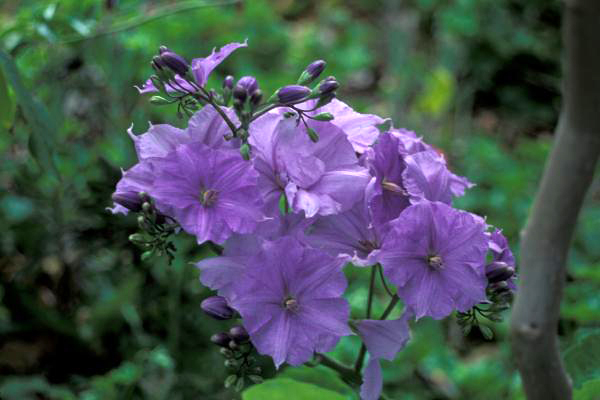 Copyright free image by Forest & Kim Starr from Plants of Hawaii site. |
 Line drawing by M. Szent Ivany, J. Adelaide Bot. Gard. 4 (1981) 70, fig. 16. |

Synonymy
Solanum wendlandii Hook.f. in Curtis's Bot. Mag. 113, t. 6914 (1887)
T: Grown at Kew from living plants sent by Dr Wendland, Director of the Royal Gardens at Herrenhausen, Hanover, originally from Costa Rica; syn: K, 2 specimens, lectotype to be designated.
The protologue and image in Curtis's Botanical Magazine is visible on the web through the Botanical Digital Library at www.botanicus.org/page/431916
Description
Vigorous climber, green; glabrous except for hairs on corolla tips; prickles hooked, scattered on main stems and leaves or absent.
Leaves ovate; lamina 11–22 cm long, 4–8 cm wide, concolorous, entire or deeply lobed, the lobes often cut to midrib and lowest pair sometimes petiolulate.
Inflorescence showy, terminal panicle of cymes up to 20 cm long; pedicels to 15 mm long. Calyx 4–6 mm long; lobes 2-3 mm long, oblong, cuspidate. Corolla pentagonal-rotate, 30–50 mm diam., pale lilac-blue. Anthers 10 mm long, oblong.
Berry (not seen) reported as ovoid, 35–40 mm diam., yellowish or 10-15 mm diam., dark green turning to red at maturity. Note however that the Solanaceae Source site documents them as " Fruits ca. 3-5 cm in diameter, globose, green with green to white pulp, glabrous with rugose surface when dry."
Distribution and ecology
Native of Costa Rica. Commonly grown as an ornamental in Australian gardens.
At the time of writing of the Solanum treatment for Australia (Symon 1981; Purdie et al. 1982) S. wendlandii was not known to be naturalised and it would appear that there are still (2009) no records of it naturalising in any of the Australian states - only a single record was found in attempting to generate a map from Australia's Virtual Herbarium and this probably related to a cultivated specimen in Adelaide; the lack of naturalisation presumably relates to the lack of formation of fruits by cultivated plants in Australia and elsewhere.
Common name
[Giant] Potato Vine, Blue Potato vine, Giant Potato creeper, Costa Rica nightshade, Paradise flower
Relationships
Relationships of S. wendlandii are still to be clarified. It was treated as part of the Wendlandii group of subg. Leptostemonum by Whalen (1984), despite the lack of stellate hairs and the possession of oblong, rather than tapering anthers.
Bohs' (2005) and Levin et al.'s (2006) molecular studies suggest removal of this group of species from subg. Leptostemonum and this was supported by Miz et al. (2008). It is treated in the Wendlandii/Allophyllum clade in the Solanaceae Source site.
Notes
Cultivated plants possibly only have male flowers and therefore fruits are rare. Propagation is mostly by cuttings and this species is generally regarded as non-invasive. There is further discussion of this on the Solanaceae Source site.
Description of the fruits from South American populations, where the plant is native, are contradictory.
Derivation of epithet
Named for Dr. Dr. Hermann Wendland (1825-1903), Director of the Royal Gardens at Herrenhausen, Hannover who sent the original plants to Kew.
From the web
The flowers of S. wendlandii can be seen on the Plants of Hawaii site.
More likely to encountered in cultivation, there is a series of images of S. wendlandii on the Dave’s Garden site.
The United States Department of Agriculture Germplasm Resources Information Network (GRIN) has numerous links for this species.
Further information and links can be found on the Solanaceae Source site.